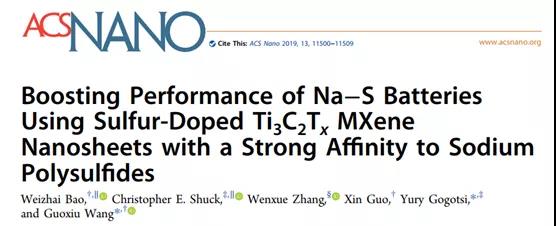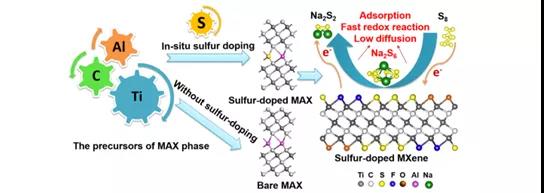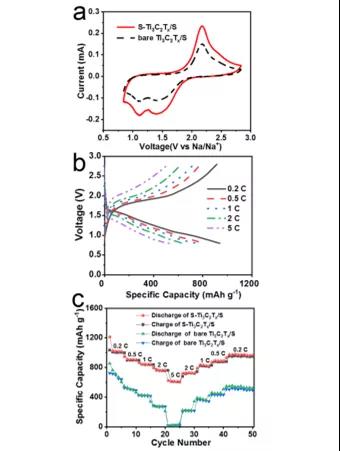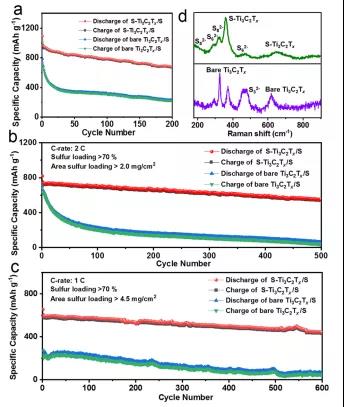S-MXene for high performance Na-S batteries
QQ Academic Group: 1092348845
Detailed

【Research Background】
In order to meet the growing demand for electric vehicles and grid applications, high energy density rechargeable batteries, especially lithium ion batteries (LIBs), are widely used. However, due to the high cost and availability of lithium resources, there has been concern about lithium batteries. Room temperature sodium-sulfur batteries (RT Na−S) are promising due to their high theoretical energy density (1274 W h kg−1) and large reserves and low cost of sodium and sulfur. However, RT-S batteries have disadvantages such as low reversible capacity, poor self-discharge, and poor cycle performance, which hinders their wide application. The natural insulation of elemental sulfur limits its use as an active material, resulting in slow electrochemical kinetics of the cathode. At the same time, the solubility of sodium polysulfide after reduction in charge and discharge is much more serious than that of lithium polysulfide, which aggravates the uncontrollable shuttle effect of sodium polysulfide, resulting in poor cycle life of RT-S battery. Due to its two-dimensional structure, functional surface, high electrical conductivity and chemical durability of the battery, MXenes has broad application prospects in rechargeable batteries, supercapacitors, catalysts, electromagnetic shielding, electrochromic materials, and antennas. Especially in the fields of high-rate lithium-sulfur batteries, capacitors and RT sodium batteries.
[Introduction]
Recently, Professor Wang Guoxiu of the Clean Energy Technology Center of the University of Technology, Sydney University of Technology and Yury Gogotsi of the University of Drexel jointly published in ACS Nano: Boosting Performance of Na−S Batteries Using Sulfur-Doped Ti3C2Tx MXene Nanosheets with a Strong Affinity to Sodium Polysulfides
Sodium-sulfur batteries use abundant elements to provide an attractive alternative to the batteries currently in use, but they require better sulfur-containing materials to compete with lithium-ion batteries for capacity and cycle capacity. In this paper, an in-situ sulfur doping strategy was proposed to functionalize MXene nanoflakes by introducing heteroatomic sulfur from the MAX precursor into the MXene structure. Three-dimensional pleated MXene nanostructures with high specific surface area were prepared by vacuum freeze-drying. In a room temperature sodium-sulfur battery, a special shrinkage sulfur-doped MXene (S−Ti3C2Tx) nanosheet is used as the electrode host material. The S−Ti3C2Tx group is highly polar with sodium polysulfide, which limits the diffusion of sodium polysulfide. The MXene/sulfur electrode achieves a high area loading of sulfur up to 4.5 mg cm−2 and good electrochemical performance (reversible capacity of 577 mAh g−1 at 2C after 500 cycles).
[Graphic introduction]

Figure 1 is a schematic diagram of the synthesis process of in situ sulfur doping

Figure 2 shows the physical characterization of sulfur-doped MAX and MXene.

Figure 3 shows the material pore size analysis, thermogravimetry, XRD and XPS spectra.

Figure 4 shows the half-cell performance test. It can be seen that the S-doped MXene sodium sulfate battery has relatively excellent rate and cycle performance.
[Summary of this article]
The three-dimensional pleated S-doped MXene structure can be effectively used as the electrode body of a high performance sodium-sulfur battery. The S−Ti3C2Tx /S electrode has high capacity and good cycle performance. XPS, Raman spectroscopy and DFT calculations confirmed the strong chemical adsorption capacity of s-doped MXene for sodium polysulfide. The high specific capacity and good cycle performance indicate that the s-loaded pleated MXene system has broad application prospects in sodium-sulfur batteries. In addition, this study also illustrates the feasibility of chemical modification of the MXene surface by doping a site of the MAX phase precursor. In addition to cutting the M and X elements, the number of atomic layers (n), and etching conditions (time, temperature, and composition), the use of a site doping has been shown to further modify surface chemistry and enhance MXene performance.
Literature link:
DOI: 10.1021/acsnano.9b04977
Source: WeChat public account MXene Frontier
- Previous: High performance MQW p
- Next: 1


 About us
About us